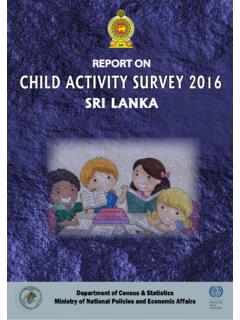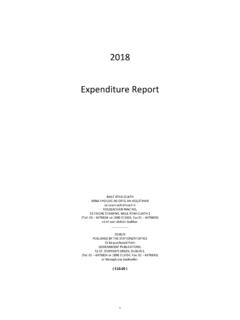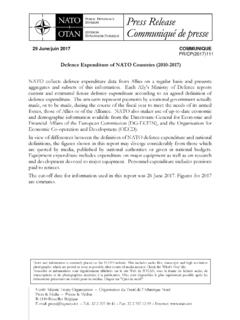Transcription of Department of Census & Statistics Overview
1 Department of Census and Statistics June 2013 Overview Main objectives Household Income and expenditure Survey 2012/13 Preliminary Results of First Three Monthly Rounds (July, August, September 2012) tricts after 26 years. The last survey (related to this survey- Labour Force and Socio Economic Survey ) covered the whole country was in 1985/86 period. The Department of Census and Statistics (DCS) conducts the Household Income and Expendi-ture Survey (HIES) under the Na-tional Household Survey Pro-gramme. The HIES had been con-ducted in combination with La-bour Force Survey named as La-bour Force and Socio-Economic Survey till 1990. DCS first initiat-ed the HIES as a separate survey in 1990 and since then it has been continued once in every five years till 2006/07. In response to the rapidly changing economic condi-tions the DCS decided to conduct the HIES once in every three years starting from 2009/10 which ena-bled to monitor the income and spending patterns in the country far more frequently.
2 Generally the HIES is con-ducted over a period of 12 consec-utive months to capture seasonal variations of income and expendi-ture patterns in Sri Lanka. The general sample size is 25,000 housing units which is adequate to provide reliable information down to district level. The HIES 2012/13 is the eighth in its series. The field work of this survey was car-ried out during the period from July 2012 to June 2013. The HIES questionnaire was revised in 2006/07 and now it con-sists of nine sections to collect household information covering the following areas. i. Demography ii. School education iii. Health iv. Food and non-food expenditure v. Income vi. Inventory of durable goods vii. Access to facilities in the area and debts of the households viii. Housing Information ix. Agriculture holdings and Livestock Coverage of the Survey Information present-ed in this bulletin is based on the data collect-ed from 5,431 household throughout the country during the months (July, August and September, 2012) Collection of data in this survey is successfully covered in all the dis-Inside this issue: Population 2 School attendance 2 Health 2 Household income 3 Gini Coefficient 3 Per capita income 3 Income receiver s income 4 Household expenditure 4 Food expenditure pattern 5 Changes of Non-food expenditure 6 Special points of interest: 2012-HIES Average monthly household income Rs.
3 46,207 Median monthly household income Rs. 30,400 Average monthly Per-capita income Rs. 11,932 Average monthly Income receiver's income Rs. 25,778 Average monthly household expenditure Rs. 40,887 Household size persons Number of income receiver's per household persons Department of Census & Statistics June 2013 i. To measure levels and changes in living con-ditions of the people. ii. To observe the con-sumption patterns. iii. To compute various other human develop-ment and socio eco-nomic indicators such as poverty, price indi-ces etc. ISSN-2279-3968 Department of Census and Statistics June 2013 In the health section of the survey questionnaire, the data was collected from each and every person usually living in the surveyed household considering two different reference periods. One month (last month) reference period was consid-ered to investigate if the person has re-ceived any medical treatment as out-patient in any government or private hos-pital, medical center or healthcare center and to investigate about persons who received medical treatments as in-patients at any government or private hospitals as , the one year (last year) reference period was considered The survey shows that in a month, nearly of the household popula-tion obtains health treatments as out-patients per month.
4 Population School attendance Preliminary Results Household Income and expenditure Survey 2012/13 Page 2 The survey reveals the estimated house-hold population in 2012 is million in Sri Lanka. When the three residential sectors are considered, majority of the population (78%) is in the Rural sector which recorded as million. Popula-tion in the Estate sector is million which is 5 % of the total population in Sri Lanka. Urban sector population rec-orded as million. Female population is higher than the male population in Sri Lanka. The female population reported in the survey is million. However there is no considerable differences of distribution pattern of male and female population in the urban and estate sectors . Figure 02 :Health status of household population (percentage) by sector 2012 The thousand mysteries around us would not trouble but interest us, if only we had cheerful, healthy hearts.
5 Friedrich Wilhelm Nietzsche Table 1: Household population (in mil-lions) by sex and sector - 2012 Table 2: Percentage distribution of school attendance of children aged 5-14 years by sector - 2012 Figure 01 :Household population in Sri Lanka-2012 Health Urban17%Rural78%Estate5%Household Population -2012 The HIES 2012 reveals that among the total child population aged 5 to 14 years in Sri Lanka, children are currently attending school. In rural sector school attendance rate is and in other two sectors also record almost the same percentages. This analysis defines the School attendance as current attendance at any government, private, international or any other recognized school which provides regular education for children and the children in the age group of 5 - 14 years are considered as the target population in which the school attendance is compulsory by law.
6 LankaUrbanRuralEstatePercentage(%)Out patitient health care (Monthly)Treatment at hospital as inpatient (yearly)Suffering from chronic disability The roots of education are bitter, but the fruit is sweet. Aristotle Department of Census and Statistics June 2013 The HIES 2012 has found that the average monthly household income in the Urban sector has risen only by 43% from 2009/10 (from Rs. 47,783 to ,336). However, the corresponding increase for the median household income is from Rs. 31,000 to Rs. 41,958 in 2009/10 to 2012 respectively. In 2012 the average monthly household income in the Estate sector has increased by 32% (from ,162 to ,895 from 2006/07 to 2012 survey period. For same period ,the median income has increased in the Estate sector by from Rs. 17,366 to ,664. Household income refers to income received either in cash or (Monetary income) or in kind (Non-monetary income) by all the residents in a household.)
7 This includes not only wages and salaries but also all the income generated by other sources such as agricultural and non-agricultural activities, other monitory receipts (social protection transfers) such as pen-sion, disability and relief payments, regular rental and remittance receipts and returns from businesses or investments and any other irregular gains such as compensations, lotteries etc. The survey reveals that the average household income per month is Rs. 46,207 in 2012 in Sri Lanka. In 2009/10 the average household income was reported as Rs. 36,451. Within nearly year period, the percentage in-crease of the household income at current prices is nearly %. However, for the same period the real income (adjusted for the inflation of prices) shows the increase is approximately The median household income in Sri Lanka has reported as Rs. 30,400 in 2012 showing an increase of about 28 % from 2009/10 and the real me-dian household income has also increased by % from 2009/10 to 2012.
8 The national value of the Gini coeffi-cient is in 2012 which shows a slight drop from reported in 2009 the sector level the Gini coeffi-cient was , and in Urban, Ru-ral and Estate sectors respectively in 2012. There are many theories to explain how income inequality comes about. The most widely used single meas-urement is Gini coefficient. The range of the Gini coeffi-cient index is between 0 and 1, where 0 indicates perfect equality and 1 indicates maximum inequality. Household Income Page 3 Per capita income indicates the average living standard of a country or an area. In 2012 the per capita income in Sri Lanka is Rs. 11,932 per month. In 2009/10 it was Rs. 9,104 and has increased by 31% from then to 2009/10. Urban sector shows the highest mean ( ,150) and median ( ,167) per capita income among the 3 sectors. Figure 3: Average monthly real and nominal Mean household income by survey periods Gini Coefficient Table4:Monthly mean and median household income by sector - 2012 Table 3: Average monthly household median income by Survey periods Per capita Income Preliminary Results Household Income and expenditure Survey 2012/13 Table 5: Gini coefficient of the household income by sector by survey periods Note: Based year for real values - 2006/07 26,28636,45146,20726,28626,41427,8362500 030000350004000045000500002006/072009/10 2012 IIncome(Rs.)
9 Survey PeriodsNominal mean incomeReal mean income Department of Census and Statistics June 2013 Household expenditure was collected under three main sections; 1. expenditure on food items 2. expenditure on non- food items and 3. expenditure incurred by boarders an domestic servants To improve the quality of the data and data collection, the HIES question-naire imposes different reference periods age increase from 2009/10 to 2012 are for food and for non-food respectively ( Food -Rs. 13,267, Rs,15,358 and Non-food - ,065, ,529 for 2009/10 and 2012 respectively). When the 3 sectors are compared over the period from 2009/10 to 2012, the mean household expenditure has increased by in the Urban sector while the Estate sector shows increase. on different consumer items grouped depending on the general frequency of acquiring or purchasing of the items.
10 Seven consecutive days for all the food items, one month for Housing and Fuel and Light etc., six months for Clothing, twelve months for Durable goods etc. The Table 7 shows that the aver-age household expenditure in Sri Lanka in 2012 is ,887 in which Rs. 15,358 (38%) is the expenditure on food consumption and Rs. 25,529 (62%) is on non-food items and ser-vices. When compare the food and non-food expenditure at sector level, the Urban and the Rural sector household spend more on non-food than food. But the Estate sector non food expenditure and food expenditure are almost equal .The average household expendi-ture reported in 2009/10 was Rs. 31,331 which has increased by since then to 2012. The food expenditure and the non-food expenditure , the percent-Income receiver's income Household expenditure Be a money spinner Page 4 In order to obtain the Income receiv-er s income, the HIES records the house-hold income that received from all the sources, at person level.













